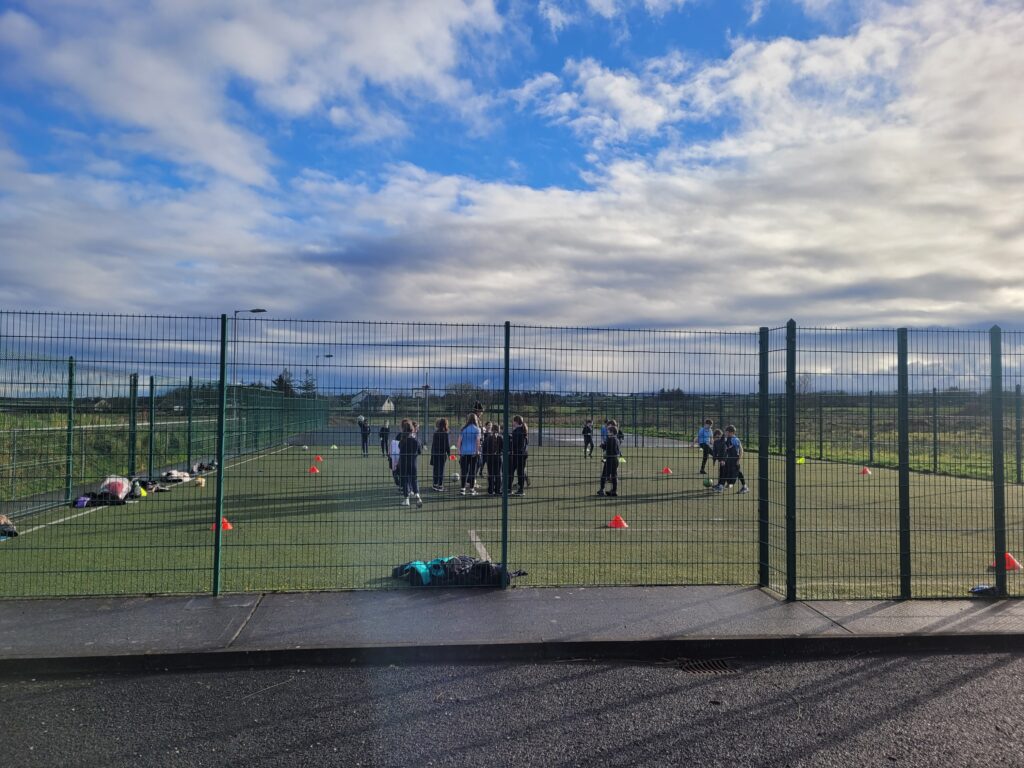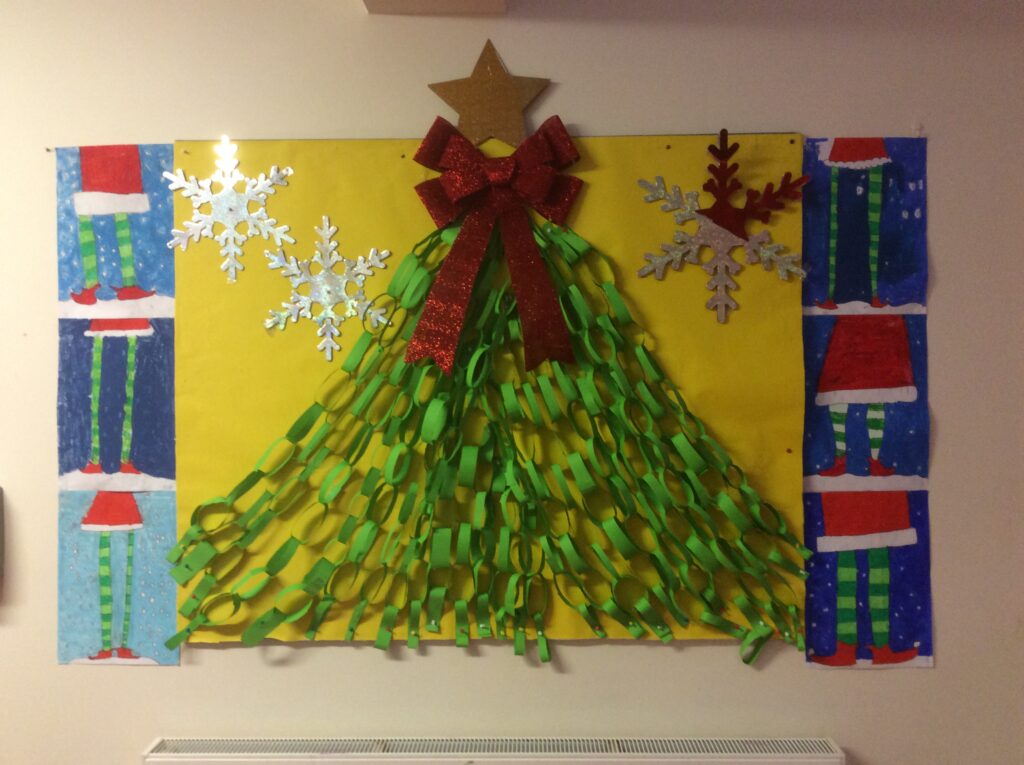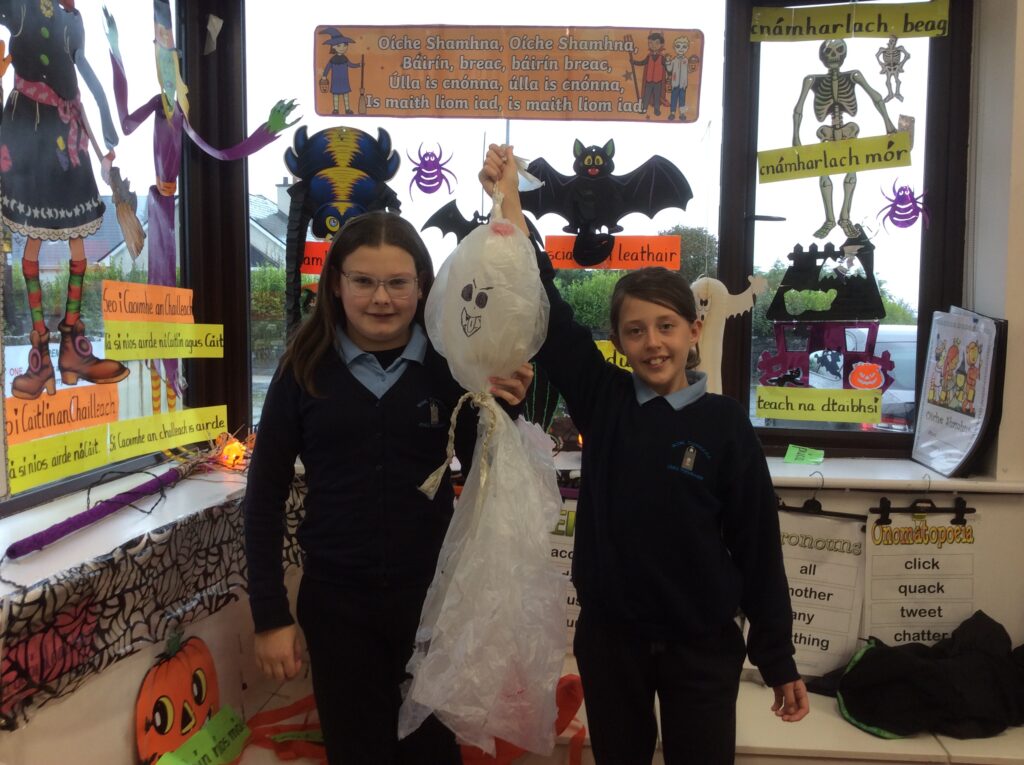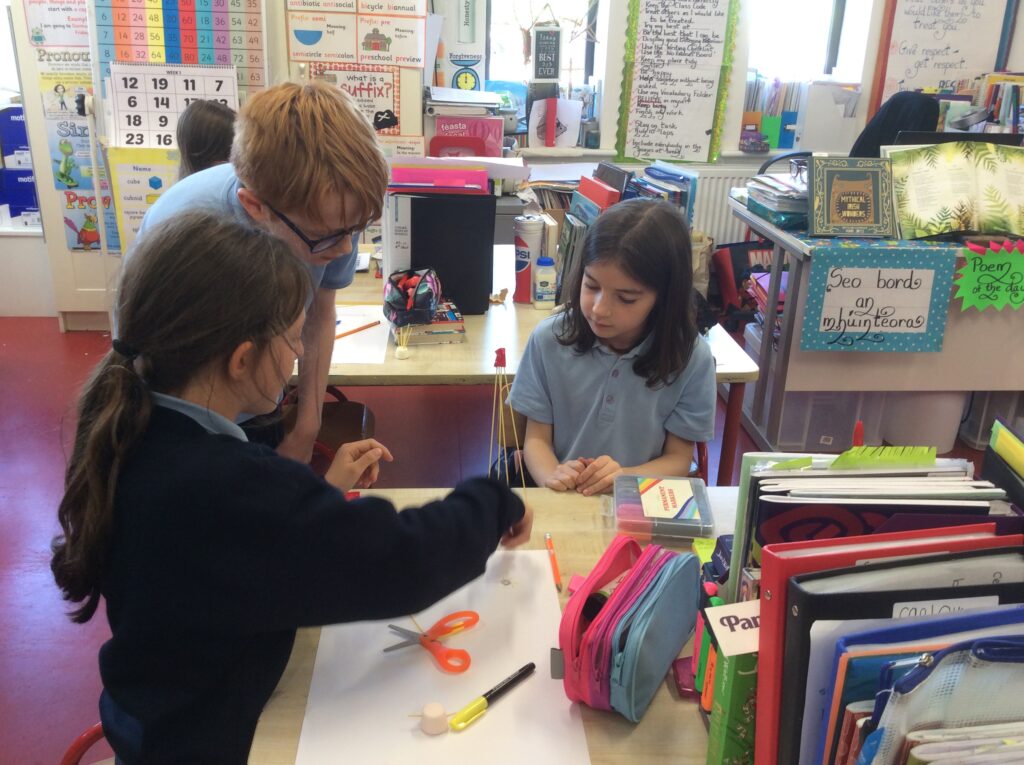December Art
Inspired by the abstract and pop artists, Vassily Kandinsky and Romero Britto, we created a large Christmas tree using individual abstract art smaller Christmas trees.
We created another Christmas tree using chains with a bright star crowing our tree.
The monochrome Christmas trees were created using white paint on black/blue paper.
We had fun creating our Christmas Art!!
In November We Remember

Spooky Scary Woods October
The second annual Scary Woods walk was held in Kilglass House Woods this year.
Our creations were designed and produced after discussing at length how we wanted our designs to look, sound, using sustainable materials that were recycled where possible.
Using plaited bin bags, shells and milk cartons, our Púcas came to life.
Súleach, based on the mythological Donegal monster who was covered in eyes, was produced using recycled CD’s and DVDs.
We also created witch’s legs hanging from the branches of the tress.
We really enjoyed the spooky fun!
October Art
Romero Britto, a famous pop artist, was our Artist of the Month for October. His use of pattern and colour inspired our October masterpieces.
STEAM Challenge – Spaghetti Marshmallow Tower
Using only 18 pieces of spaghetti, one metre of tape, and a scissors, each group designed and constructed a free-standing tower that could hold a marshmallow on top!
We used science, technology, engineering, art and mathematical skills to complete this fun task.
September Art
Vassily Kandinsky was the Artist of the Month in September. Inspired by his use of line, colour and shape to create non-representational art, these pictures showcase our abstract art this month.
Fáilte-Welcome to Ms. Brogan’s Room 2023-2024

Writing Genres
Recount Writing
To retell past experiences.
Purpose:
Personal
Factual
Imaginative
Framework
Setting:
Who? What? When?
Where? Why? How?
Events:
In time order
Concluding Statement:
**Recount writing is always
written in time order**
Examples:
My School Tour
St. Patrick’s Day
Language Features:
Specific participants
Linking words to do with time, e.g. later, after, before
Paragraphs in time order sequence
Action verbs
Simple past tense
Report Writing
To present factual information.
Purpose:
Objects
People
Places
Animals
Framework
Classification:
What is it?
Description:
Size? Shape? Features?
Place/ Time:
Where? What?
Dynamics:
What does it do?
Summarising Comment:
Example:
Frogs
Language Features:
Generalised participants
Impersonal objective language
Timeless present tense
Subject specific vocabulary
Procedural Writing
To list steps to follow in making/doing something
Purpose:
Give instructions on how to operate something e.g. washing machine
Show steps for making and doing e.g. baking a cake, playing a game
List sequences of actions e.g. find a location
Framework:
Aim:
What is to be done
Requirements:
List of what is needed
Method:
How to do it
Evaluation:
Was it successful?
Examples:
Cooking
Directions
Language Features:
Detailed factual description
Reader referred to in a general way or not mentioned at all, e.g. draw a line
Linking words to do with time e.g. after, as soon as
Tense is timeless
Action verbs often begin each sentence
Persuasive Writing
To persuade others in argument or debate
Purpose:
persuade readers to agree with one point of view
show all points of view and reach conclusion e.g. debate
argue a case
Framework:
State Problem/ Argument
Arguments for and supporting evidence
Arguments against and supporting evidence
Conclusion
Example:
Mobile phones should be banned
Language Features:
Generalised participants
Passives to help text structure
Linking words associated with reasoning e.g. therefore
Nominalisation (actions become things) e.g. to pollute becomes pollution
Explanatory Writing
To explain how things work or came to be.
Purpose:
Explains how things occur e.g. how does a rainbow occur?
How things work e.g. how do engines work?
Why things are or happen
Framework:
Definition:
What is it?
Parts:
Describe
Operation:
How it works
Application:
When/Where it works, how it’s used
Interesting Features:
Comment:
Evaluation:
Example:
How erosion occurs
Language Features:
Generalised non-human participants
Cause and effect relationships
Some passives e.g. is driven by
Timeless present tense e.g. soil is deposited
Narrative Writing
To tell an imaginative story, but this may be based on fact.
Framework:
Title:
Setting:
Who? Where? When?
Initiating Event:
How did the characters get involved?
Problem:
What is the problem? What is the conflict?
Resolution:
How was it solved?
Examples:
• Fairy tales
• Novels
• Fables
Language Features:
Usually past tense
Defined characters
Dialogue
Descriptive language to create images
Linking words to do with time
Comprehension Strategies
Predicting is like being a detective.
I can make predictions before and during reading.
I think about the information I know from the cover, pictures and the story.
I think about what will happen next and listen to the author’s clues.
It doesn’t have to be right!!
“I predict that …”
Explains why
Use prior knowledge
Use evidence and clues
What has happened so far?
What is the reason for your prediction?
Why do you think that?
What clues are you using to predict?
What will happen next because of this event? Why do you think this will happen?
We can ask questions anytime!
They help us to think more about what we read.
Sometimes we can find answers to our questions in the story or using our background knowledge.
Sometimes the author leaves us wondering!
Asking questions helps us to “solve” the story by putting all the pieces together.
“I wonder …?”
“Here” questions have obvious answers
What? When? Where? Which? How?
“Head” questions
Use your own thoughts, feelings and opinions
Use prior knowledge to make connections
Was it something that happened that made you think that?
Do you need to infer?
“Hidden” Questions
Try to use all the clues from the story so far.
Think about the characters in the story and the things they are doing
Why do you think he did that? How do you know?
Why do you think she felt that way? How do you know?
Why do you think he said that? How do you know?
Picture / movie in your head
We use our “movie” to help us picture the story inside our heads. Smells, sounds, taste and touch can make your movie better.
The words are like the script.
Change your movie as you get more information.
Everybody will have a slightly different movie.
Are you connecting with something?
My picture is slightly different …
Why did that picture come into your head?
Can you describe what you saw in the film of you head while reading?
Can you describe something you could see? / feel? / touch? / hear?
We can make connections at any time.
You think about something that happened in the story that reminds you of something else in:
The Story – Text to Text
Your Own Life – Text to Self
The World – Text to World.
Our background knowledge is very important here.
It makes the story come to life and you can imagine it better.
“It reminds me of …”
Did you make a connection with this text?
Did it remind you of anything?
What type of connection is that?
This strategy encourages readers to constantly ask themselves what is important in a sentence, phrase, paragraph, chapter or whole text.
I can understand the main ideas of the text and what the author’s message is.
The text was mostly about…
The important details were…
I will underline the key words ….
I think … and … are important
Who, what, when, where, why …
Famous Five Key Word Search
What’s Your Story
Main Idea Pyramid
Summarising is the ability to reduce a larger piece of text so the focus is on the most important elements of the text.
When I summarise I can think about what I have read and then focus on the most important elements.
First, next, finally, then…
I think the purpose of this text was to…
I can think about the most important parts and retell them in my own words…
I am text block. Click edit button to change this text. Lorem ipsum dolor sit amet, consectetur adipiscing elit. Ut elit tellus, luctus nec ullamcorper mattis, pulvinar dapibus leo.





